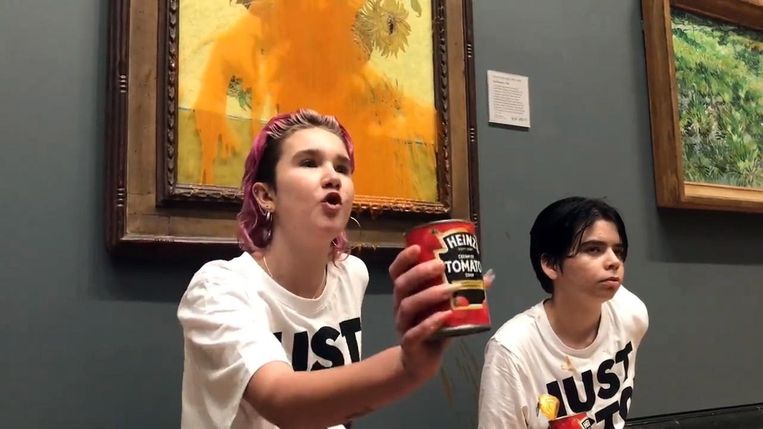Van Gogh soup sunflower It did not generate much interest in the state of the climate, but in the damage that the famous painting would have suffered. “Here only a piece of cloth should have been washed. Why don’t the media pay more attention to the message of these activists?”
At the National Gallery in London, sunflower by Vincent Van Gogh for Return. On Friday, the masterpiece had to be removed for a while, after it was doused with tomato soup by two environmentalists from British working group Just Stop Oil.
Activists drew attention to the climate, but then there was more to say about the damage the painting could incur. It turned out to be okay. The painting itself, valued in the millions, is protected by glass. Only the frame was slightly damaged.
The two activists, two young women from Newcastle and London, have been arrested for vandalism. The judge released them on bail, but they risk paying a hefty fine. “Some of the actions are counterproductive,” says Walter Lutens, 80, who has been campaigning for the climate for years. In the 1970s he protested against the oil giant Shell. Lutens was one of the founders of the Action Group for Critical Education (AKO) and is today one of the driving forces behind the Ancestral Climate Programme. “The Right has a lot of influence on social media and the act has bounced back like a throwback. Activists are now presented as cultural barbarians.”
‘time is running out’
However, according to Lutens, drastic action is needed. “Having a conversation for the umpteenth time has no effect. Time is running out and unfortunately the impact of climate absentees has been very limited. I am convinced we need to be more radical. Last week, the Ancestral Climate Program joined Code Rouge in Hainaut, blocking access to The TotalEnergies plant,” says Lutens, who was unable to attend due to health issues.
“In my opinion, Code Rouge has been a very successful campaign,” says Lutens. The timing was right and we got a lot of media attention. While we worked, the ministers were in a closed meeting of their budget. It is an activist’s dream to have an impact on the political side.”
“It is unfortunate that the success of the protest campaign is often expressed in its impact on policy,” says Kato Wetterlos, a postdoctoral researcher at the University of Ghent who studies climate activism. “It is very rare for a particular action to have a direct result of a policy change. Other parameters are possible. If their intent is to create awareness, the Just Stop Oil action has succeeded. It is clear that activists struck a chord.”
Events at the National Gallery made headlines across Europe. The video of the accident was viewed on YouTube by 47 million views only on Sunday. The soup that ran over the famous painting created a kind of shock effect. But shouldn’t that also cause climate aversion?
“This is a risk,” says the researcher. Political action is becoming more and more individualistic and less tied to fixed groups. This makes it easier to color outside the chalk lines than we are used to. This goes hand in hand with the logic of social media: each person gives their own interpretation of what the movement represents and what narrative you are spreading. This also makes it easier to hijack a movement. This seems to be happening now: people are evaluating the intentions of online activists, which may not align with the real intentions.”
risk weight
“But cash has its value, too,” Waeterloos says. “I found it very surprising to see criticism change when it became clear that the board wasn’t really damaged. Political commitment is often measured by risk. The higher the personal risk, the greater the commitment. Online engagement is seen as the least valuable. Those who put the time and effort out They themselves are more involved. According to this logic, permanently destroying a work of art is really honest.”
“It would be a different discussion if the artwork was effectively damaged,” says article writer Gert Bellins, who is deeply committed to climate change. “But there was no harm here: only a piece of cloth to be washed. I am sure the activists knew the work was protected by glass. What are we talking about next? So why don’t the media pay more attention to the real message of these activists who wanted to denounce? Social inequality: while we spend exorbitant sums on art, there are people who do not have the money to heat a can of soup.”
Buelens wrote the book earlier this year What we already knew then, which takes him back 50 years and examines what happened to environmental activism in the 1970s. From health insurance to women’s suffrage, every major change came through mass protest with a radical wing. Unfortunately, the friendly question did not bring about any structural change. The demonstration no longer had any effect. A few months ago, a climate activist set himself on fire, but we all forgot about it. The battle against climate change must be fought with the same unrelenting urgency with which nations go to war.”

“Friendly communicator. Music trailblazer. Internet maven. Twitter buff. Social mediaholic.”









More Stories
Actors Intentionally Cut From Sci-Fi Epic ‘Megalopolis’: ‘Not a Woke Hollywood Movie’
Caroline Rego: “The golden rule is: for every glass of alcohol, one glass of water to replace it!”
Director of 1994’s The Crow Praises Remake’s Failure: ‘It’s a Bloodbath’